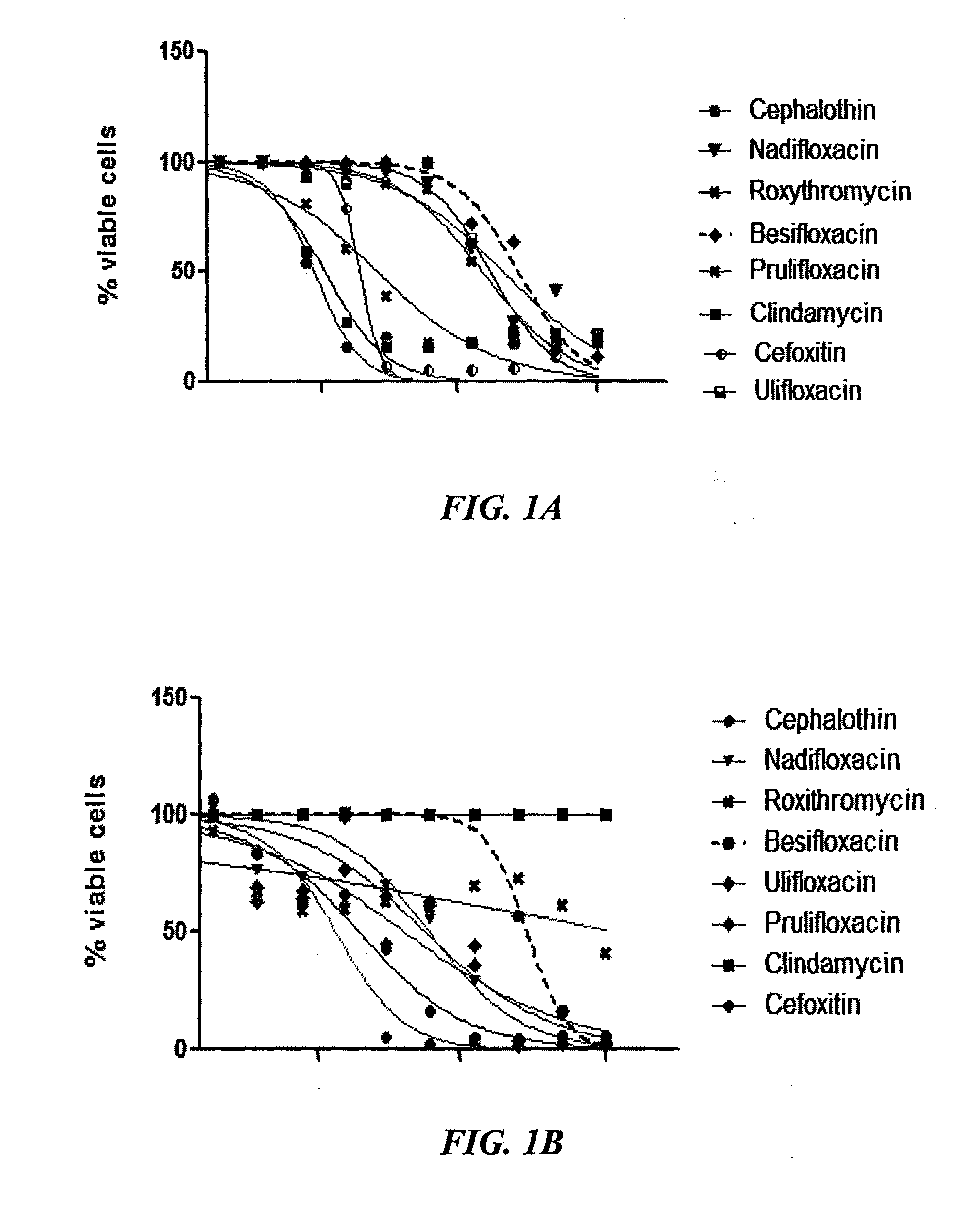Treatments for resistant acne
a technology for acne and treatment, applied in the field of new molecules, compositions and formulations for treating bacterial infections, can solve the problems of limited use of topical formulations, scarring or disfigurement permanent, and overproduction of sebum by the pilosebaceous gland, so as to prevent the development of resistance, reduce the chance of mutation development, and alter the level of inflammatory cytokines
- Summary
- Abstract
- Description
- Claims
- Application Information
AI Technical Summary
Benefits of technology
Problems solved by technology
Method used
Image
Examples
example.1
Example. 1
[0387]Screening of antibiotics against P. acnes strains shows that the response is unpredictable in both clindamycin-sensitive and non-responder strains
[0388]Examples 2-15 and Tables 6-15 describe some exemplary DART molecules, their synthesis, formulations and uses.
Example 2
Synthesis of DART Molecule 9 (from Table 1A)
[0389]
[0390]Step 1. Synthesis of 2: To a solution of 1 (1 g, 2.33 mmol) in mixture of dichloromethane (10 ml) and dimethylformamide (1 ml) was added N,N-dicyclohexylcarbodiimide (0.627 g, 3.041 mmol) followed by N-Hydroxybenzatriazole (0.316 g, 2.33 mmol) slowly at ice cold condition and stirred at RT for 2 h to obtain turbid suspension. To this turbid solution pentanediol (0.85 ml, 8.18 mmol) was added followed by 4-dimethylaminopyridine (0.284 g, 2.33 mmol). The final reaction mixture was stirred at RT for 16 h. The white precipitate was filtered and extracted with ethyl acetate. The filtrate was washed with brine solution, dried over sodium sulphate and ev...
example 2
Synthesis of DART Molecule 87 (from Table 1A)
[0392]
[0393]Step 1. Synthesis of 4: 11-Bromoundecanoic acid (1.33 g, 5.04 mmol) was pre-mixed with the methanol (0.1 ml) was added into a stirred mixture of 1 (1 g, 2.52 mmol), potassium carbonate (0.243 g, 1.764 mmol), and dipotassium-hydrogenphosphate (0.175 g, 1 mmol) in N,N-dimethylacetamide (15 ml) at 0-5° C. The reaction mixture was stirred at 0° C. for 5 hr and extracted with ethyl acetate (50 ml). The final solution was washed with 3% aqueous sodium bicarbonate solution (10 ml) followed by brine solution (10 ml). The organic solvent was evaporated to give crude mass and finally purified by flash column chromatography. The compound was eluted with 1-3% methanol / dichloromethane to obtain pure compound, 4 (1.2 g, 82% yield).
[0394]Step-2: Synthesis of DART, 87: To a solution of Compound 4 (1 g, 1.72 mmol) in dichloromethane (10 ml) and 1 ml dimethylformamide was added dicyclohexylcarbodiimide (0.461 g, 2.23 mmol) followed by N-Hydroxy...
example 3
Synthesis of DART Molecule 90 (from Table 1B)
[0395]Bromo-acetic acid 1-chloromethyl-2-(2-methyl-5-nitro-imidazol-1-yl)-ethyl ester (II) was synthesized according to the following scheme.
[0396]To a stirred solution of 1-Chloro-3-(2-methyl-5-nitro-imidazol-1-yl)-propan-2-ol, (I) (0.79, 3.6 mmol) in dichloromethane (10 ml) was added dicyclohexylcarbadiimide (DCC) (0.9 g, 4.31 mmol) followed by bromoacetic acid (0.5 g, 3.6 mmol) and DMAP(0.44 g, 3.6 mmol) at RT. The reaction mixture was stirred at RT for 16 h. The precipitate was removed by filtration and the organic layer was evaporated to get the crude that was purified by flash column chromatography. The final compound was eluted with 1-2% methanol / dichloromethane mixture. The compound was used for the next step without further characterization.
Synthesis of 7-(4-[1-Chloromethyl-2-(2-methyl-5-nitro-imidazol-1-yl)-ethoxycarbonylmethyl]-piperazin-1-yl)-6-fluoro-1-methyl-4-oxo-4H-2-thia-8b-aza-cyclobuta[a]naphthalene-3-carboxylic acid (1...
PUM
| Property | Measurement | Unit |
|---|---|---|
| viscosity | aaaaa | aaaaa |
| pH | aaaaa | aaaaa |
Abstract
Description
Claims
Application Information
 Login to View More
Login to View More - R&D
- Intellectual Property
- Life Sciences
- Materials
- Tech Scout
- Unparalleled Data Quality
- Higher Quality Content
- 60% Fewer Hallucinations
Browse by: Latest US Patents, China's latest patents, Technical Efficacy Thesaurus, Application Domain, Technology Topic, Popular Technical Reports.
© 2025 PatSnap. All rights reserved.Legal|Privacy policy|Modern Slavery Act Transparency Statement|Sitemap|About US| Contact US: help@patsnap.com



